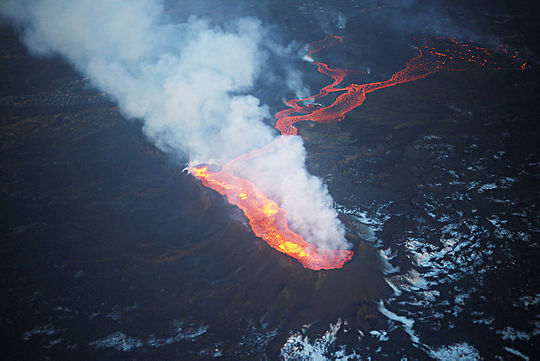Volcanic gases
Volcanic gases
Gas coming from he main crater of Holuhraun. Photo taken on 21 January 2015 by Oddur Sigurðsson.
Magma contains gases that can come out of the molten mixture as pressure is reduced as the magma moves upwards. The gases are one of the forces acting on magma: as gases come out of solution, the density of the magma changes, and help its upward movement toward the surface. Volcanic gases are able to reach the atmosphere, sometimes directly from the magma, and sometimes after significant changes due to reactions with rocks and ground water, at which point the gases are often called ‘geothermal gases' as opposed to ‘magmatic gases' . The volcanic gases can be released from soil, fumaroles, mud pots, ground waters, and/or with glacial meltwater. The composition of the gases at the surface varies due to the chemical composition and depth of the magma and any reactions that occur between the gases and the local environment.
The highest concentrations in magmatic gases are water vapor (H2O), carbon dioxide (CO2), sulfur dioxide (SO2), hydrogen (H2), carbon monoxide (CO), and hydrogen sulfide (H2S). Other minor gases include sulfur (S2), carbonyl sulfide (OCS), methane (CH4), hydrogen chloride (HCl), hydrogen fluoride (HF), and hydrogen bromide (HBr). Many other minor gases are also measured in volcanic gases.
In Iceland, we are emphasizing the continuous monitoring of CO2, SO2, and H2S gases due to being emitted by the volcanic systems in sufficient quantities to be measureable above background atmospheric concentrations. In particular, the significant presence of SO2 in volcanic gases is an indicator that the gases being measured are magmatic rather than geothermal gases. We also routinely visit gas emitting fields to collect samples for laboratory analysis of a broader spectrum of gases.
| Gases | |
| Main | Minor |
| H2O | S2 |
| CO2 | COS |
| SO2 | CH4 |
| H2 | HCl |
| CO | HF |
| H2S | HBr |
Carbon dioxide (CO2)
Carbon dioxide is denser than air and can accumulate in low-lying areas, thereby decreasing the available oxygen in the air, and can thereby cause oxygen deprivation. At extremely high concentrations, CO2 itself can cause harm to health.
Sulfur dioxide (SO2)
Sulfur dioxide has a strong smell and can irritate the nose, mouth, throat and eyes, and is particularly irritating to people with asthma. It can be lethal at high enough concentrations for a long enough time. SO2 reacts in the atmosphere to form sulfate aerosol, which also has the same harmful effects on health and can cause acid rain. When SO2 is injected high enough into the atmosphere, the later produced sulfate aerosols can have a global affect on the Earth's atmosphere. SO2 released during the 2014-2015 Holuhraun eruption had a significant impact on air quality around Iceland throughout the eruption.
Hydrogen sulfide (H2S)
Hydrogen sulfide has a strong smell and irritates the lungs, eyes, mouth and nose. This smell is often described as “rotten eggs” and is quite commonly noticed in the hot water in Reykjavík and around some geothermal areas in Iceland. Hydrogen sulfide is tolerated at higher concentrations than SO2, but is harmful at high enough concentrations for a long enough time.




